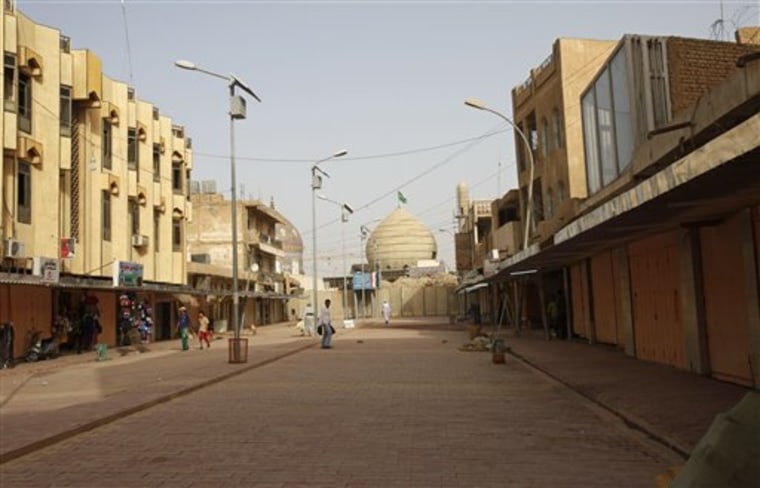The U.S. military on Tuesday handed over the last of its bases outside Samarra, a city billed as a reconciliation success story. Worries linger though that wartime remedies like barriers and checkpoints will encourage divisions and undermine hard-won security gains.
Nowhere is the split more apparent than in the half-mile passageway of blast walls leading to Samarra's famed Shiite Askariya shrine, once a flash point for sectarian slaughter. On one side of the walls are struggling Sunni shopkeepers. On the other are their traditional customers, Shiite pilgrims who for decades provided a steady stream of income for local merchants.
The shrine — ravaged in a February 2006 blast blamed on Sunni insurgents — represents the quandary facing military and civic authorities across Iraq: How much can the lockdown tactics be lifted to restore some sense of normalcy.
At the Samarra shrine, the issue pits security against economic viability. In Baghdad and other cities where some of the 15-foot blast walls have been pulled down, the neighborhoods that sat behind them have been deeply reordered by years of bloodshed between Sunnis who had power under Saddam Hussein and the majority Shiites who claimed the upper hand after the invasion.
Sunnis-Shiites divided
Few mixed areas remain and many Sunnis feel pushed aside in the effort to protect Shiite neighborhoods and places of worship. Both U.S. and Iraqi officials say that economic growth remains one of the keys to long-term stability in Iraq, but also acknowledge that the walls and other security measure remain a significant obstacle.
"It is very hard for us, and we have suffered with this wall," said Abdullah Farr, 23, who runs a kitchen appliance store that sits a few block from the Askariya shrine, one of the main pilgrim sites for Shiites from both Iraq and Iran. "The government wants to protect the mosque. But what do they do for us? For our business?"
Many say Samarra city has been forever changed by the war — and then by the effort to keep the peace: From the damaged and destroyed buildings that dot the cityscape to towering concrete walls that block roads, businesses and homes.
In the business district surrounding the mosque, about 240 mostly Sunni-owned shops have been shuttered — blocked off by the blast walls that line a major street to create the walkway for Shiite pilgrims.
In 2004, the city fell under the control of Sunni insurgents, and al-Qaida in Iraq flags could be seen flying over some buildings in the city.
Spark of sectarian violence
Then in February 2006, a huge explosion destroyed the shrine's golden dome and ignited fierce fighting between Sunnis and Shiites, killing tens of thousands across Iraq and pushing the country to the brink of civil war. In June 2007, another bombing brought down the twin minarets on the mosque's compound.
Today, with the steep decline in violence, the Shiite-dominated government has pointed to Samarra — and its peaceful streets — as an example of what is possible.
But U.S. commanders acknowledge those security gains have come with a price.
"The concrete walls that are providing some degree of security have a second and third degree negative effect," said Lt. Col. Eric Timmerman, who commands U.S. troops at a joint U.S.-Iraqi command center in Samarra, about 60 miles (95 kilometers) north of Baghdad.
As a result, the U.S. military has been advising the Iraqi government on a new security plan for the mosque that would eventually tear down the concrete divide, replacing it with a series of decorative gates, security cameras and metal detectors. There also are plans to refurbish now closed streets as part of an $1.5 million Pentagon-funded plan, said Capt. Ryan Canady, 29, of Elko, Nev.
U.S. troops leaving
The improved security in Samarra allowed U.S. forces to turn over control of Camp Brassfield-Mora — named for two soldiers killed during fighting in Samarra. It's another step in President Barack Obama's plan to remove combat forces from Iraq by the end of Aug. 31, 2010, leaving up to 50,000 troops in training roles. Under a U.S.-Iraqi security pact, all American troops must leave by the end of 2011.
The current security barriers in Samarra, however, are expected to be kept in place through next January's national elections.
Oday Taha, 36, said he longs for the days when pilgrims from Iraq, Iran and other countries flooded Samarra. Many came to his clothing store, which has been handed down in his family more two generations.
"These walls have destroyed the heart of Samarra. It has changed something forever," Taha said. "It is very difficult to make business here."
Mosque under reconstruction
The reconstruction on the mosque has entered its final phase.
Scaffolding covers the minarets and the mosque's dome where workers have been laying gold by hand. Restoration of the shrine has cost an estimated $16 million — with $8 million from the European Union and $5 million more from the United Nations. The Iraqi government paid the remainder.
Shiite tradition says the Askariya shrine is near the place where the last of the 12 Shiite imams, Mohammed al-Mahdi, disappeared. Shiites believe he is still alive and will return to restore justice to humanity.
The shrine also contains the tombs al-Mahdi's father and grandfather, the 10th and 11th imams — Ali al-Hadi, who died in 868, and his son Hassan al-Askari, who died in 874. Both are descendants of the Prophet Muhammad, and Shiites consider them to be among his successors. The famed golden dome was completed in 1905.
Rashed Alawi, a classical literature professor working in Tikrit, used to make weekly trips to pray at the mosque. Since the war began, he had only made two trips.
"There is a before and after in Samarra, for everybody who comes to Samarra," said Alawi after leaving the mosque and stopping in a nearby store to buy a snack for his trip home.
"Before, there was peace. After, no peace. Before, there were many businesses. After, no businesses."
